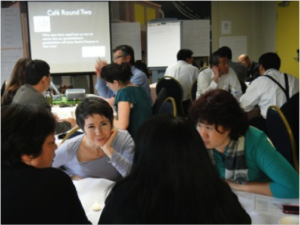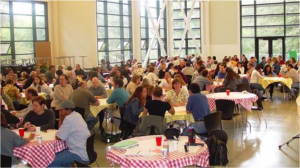Antonio Linares. Read about his model : The 6PM_by Antonio Linares Güemes
Collaborative conversation One page overview by Ken Homer
Collaborative Conversations: Include More Voices – Make Better Choices
Download this article from Ken Homer : Evolutionary Leadership Competencies
« Anything is possible when enough people realize that everything is at stake. » ~Norman Cousins
 Ken is the Founder of Collaborative Conversations. A professional meeting designer and facilitator, he became interested in how conversations get work done while a member of the team that developed the World Café dialogue process. Ken was profoundly influenced by systems thinker extraordinaire and indigenous wisdom keeper Paula Underwood. Paula taught that the circle is the greatest teaching tool known to humanity and has been used for at least 10,000 years to help people remember what is important.
Ken is the Founder of Collaborative Conversations. A professional meeting designer and facilitator, he became interested in how conversations get work done while a member of the team that developed the World Café dialogue process. Ken was profoundly influenced by systems thinker extraordinaire and indigenous wisdom keeper Paula Underwood. Paula taught that the circle is the greatest teaching tool known to humanity and has been used for at least 10,000 years to help people remember what is important.
When he encountered the proposition that all work invol ving more than one person will be coordinated through conversations, but only certain conversations coordinate work, he became intrigued with finding the shortest conversational r
ving more than one person will be coordinated through conversations, but only certain conversations coordinate work, he became intrigued with finding the shortest conversational r
oute between the conception of a work project and its completion. After many years of conversing and experimenting he developed the circle of Collaborative Conversations which is a synthesis of modern knowledge and ancient wisdom.
It’s hard to find a more convincing argument…
for radical reinvention in the workplace than the fact that what we are doing is not working. In a 2015 worldwide Gallup poll, 87% of employees reported that they are disengaged at work. Seventy percent stated their lack of engagement is due to poor managers and poor communication. It seems a lot of people have given up hope. The opportunity this presents is enormous. If we can improve engagement by even a scant 10% margin, the potential productivity gains would be worth hundreds of billions of Euros. The big question of course is how do we get people to engage?
 Collaborative Conversations grew out of action research on how conversations get work done. They are grounded in practices both ancient and modern. They draw on sources ranging from a 10,000 year old indigenous learning tradition to research from the frontiers of neuroscience. Collaborative Conversations offer a framework for inclusion, for better decision making, and for developing the individual and collective intelligence we need to address adaptive challenges. Adaptive challenges are those that require new ways of observing, listening, thinking, speaking, and working together. When nearly 9 out of 10 people are disengaged at work, it’s clear that we are facing an adaptive challenge!
Collaborative Conversations grew out of action research on how conversations get work done. They are grounded in practices both ancient and modern. They draw on sources ranging from a 10,000 year old indigenous learning tradition to research from the frontiers of neuroscience. Collaborative Conversations offer a framework for inclusion, for better decision making, and for developing the individual and collective intelligence we need to address adaptive challenges. Adaptive challenges are those that require new ways of observing, listening, thinking, speaking, and working together. When nearly 9 out of 10 people are disengaged at work, it’s clear that we are facing an adaptive challenge!
To collaborate means to co-labor, to work together, and to work with the enemy. Our workplaces and communities need to become more collaborative. People need to feel that who they are matters, that what they do is valuable, and that together, they can make a difference worth making. Collaborative Conversations tap into people’s desire for contribution, their longing for connection, and their hopes for a better future. They help to bring together people who tend to view each other with suspicion and support them in finding better ways to work. They provide people with simple tools for learning and practical skills they can use at home, at work and in their communities. Learning how to collaborate with diverse stakeholders is a critical step in building the conversational competence we will need to confront the larger systemic challenges facing us all.
The above is from the forthcoming book, Collaborative Conversations: How to Include More Voices and Make Better Choices, by Ken Homer, President, Bay Area Society for Organizational Learning.
Read the story of Ken at UC Santa Cruz : Ken Homer UCSC Qustions path
Read about the circle : Ken Homer Want to Improve Your Learning? Don’t Even Try to Think Straight! 050916
